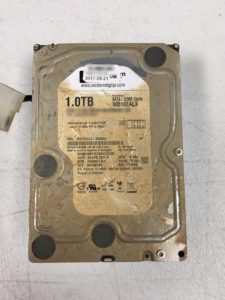When we treat water-damaged hard drives, solid-state drives, and other storage devices, we often receive the devices in plastic bags filled with white rice — which tends to complicate the data recovery process.
Of course, “put it in a bag with some rice” has been a common tactic for water-logged electronics for decades. The idea: The rice absorbs excess water, speeding up the drying process (and reducing the chances of permanent damage).
Unfortunately, it doesn’t quite work that way. Rice doesn’t “suck up” a significant amount of water; it may actually lock moisture in place, contributing to corrosion. Here’s what consumers should know.
Corrosion occurs immediately, and rice doesn’t help.
And adding rice to your storage media can create other issues. Rice isn’t clean — it’s full of starch, and, in most cases, dust from processing. The residue can damage your device’s electronics.

A hard drive with severe flood damage.
In most cases, adding rice won’t make things much worse, but it certainly won’t make things better.
When electronics are exposed to moisture, a few things happen:
- The liquid creates pathways between electronic components, raising the chances of a short circuit.
- Impurities in the liquid cause corrosion.
- If the liquid isn’t clean — which is usually the case — impurities remain on the printed circuit board (PCB) after the liquid dries. Those impurities can cause short circuits after the liquid dissipates.
Rice doesn’t help to address any of these issues. A better approach is to displace water with another liquid. 90% isopropyl alcohol is generally recommended for most electronics.
However, we do not recommend attempting to use alcohol or any other substance to clean a water-damaged data storage device. This is a recipe for disaster — most consumers won’t know how to check components prior to starting the hard drive (or SSD, or other device). Cleaning the drive may give you a false sense of security.
Related: Are Hard Drive Enclosures Airtight?
If your hard drive is submerged in water, take these steps.
First, if you don’t need the data from the device, you’re in luck: You can simply replace the drive. It’s an expensive lesson, but if no other computer components were exposed to the liquid, you’re relatively lucky — a new hard drive will set you back less than $100.
If you do need the data from the device, here’s what to do:
- Turn the computer off immediately. Unplug it from the wall; if the computer has a battery, remove it. Don’t worry about going through a typical shutdown process. Remove the power source as quickly as possible.
- Keep the hard drive powered off. Don’t attempt to clean it or dry it off. Using a fan could force liquid deeper into the components, and as we’ve discussed, chemical cleaners can create other issues.
- Contact a professional data recovery company. Choose a provider that operates full-service laboratories with certified cleanrooms.
- Package your hard drive carefully. Place the drive in an anti-static bag. Don’t add liquid to the bag or attempt to dry the device.
The good news: Most water-damaged hard drives are completely recoverable. Engineers will need to clean the device, repair or replace damaged components, and create a full copy (or clone) of the drive. This must be handled in a certified cleanroom — but the chances of a successful case result are quite high.
Datarecovery.com provides risk-free evaluations and a no data, no charge guarantee, which gives you peace of mind as your case progresses. To learn more, call 1-800-237-4200 or schedule a data recovery evaluation online.




